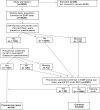Livestock-associated risk factors for pneumonia in an area of intensive animal farming in the Netherlands
- PMID: 28362816
- PMCID: PMC5376295
- DOI: 10.1371/journal.pone.0174796
Livestock-associated risk factors for pneumonia in an area of intensive animal farming in the Netherlands
Abstract
Previous research conducted in 2009 found a significant positive association between pneumonia in humans and living close to goat and poultry farms. However, as this result might have been affected by a large goat-related Q fever epidemic, the aim of the current study was to re-evaluate this association, now that the Q-fever epidemic had ended. In 2014/15, 2,494 adults (aged 20-72 years) living in a livestock-dense area in the Netherlands participated in a medical examination and completed a questionnaire on respiratory health, lifestyle and other items. We retrieved additional information for 2,426/2,494 (97%) participants from electronic medical records (EMR) from general practitioners. The outcome was self-reported, physician-diagnosed pneumonia or pneumonia recorded in the EMR in the previous three years. Livestock license data was used to determine exposure to livestock. We quantified associations between livestock exposures and pneumonia using odds ratios adjusted for participant characteristics and comorbidities (aOR). The three-year cumulative frequency of pneumonia was 186/2,426 (7.7%). Residents within 2,000m of a farm with at least 50 goats had an increased risk of pneumonia, which increased the closer they lived to the farm (2,000m aOR 1.9, 95% CI 1.4-2.6; 500m aOR 4.4, 95% CI 2.0-9.8). We found no significant associations between exposure to other farm animals and pneumonia. However, when conducting sensitivity analyses using pneumonia outcome based on EMR only, we found a weak but statistically significant association with presence of a poultry farm within 1,000m (aOR: 1.7, 95% CI 1.1-2.7). Living close to goat and poultry farms still constitute risk factors for pneumonia. Individuals with pneumonia were not more often seropositive for Coxiella burnetii, indicating that results are not explained by Q fever. We strongly recommend identification of pneumonia causes by the use of molecular diagnostics and investigating the role of non-infectious agents such as particulate matter or endotoxins.
Conflict of interest statement
Figures
Similar articles
-
Associations between pneumonia and residential distance to livestock farms over a five-year period in a large population-based study.PLoS One. 2018 Jul 17;13(7):e0200813. doi: 10.1371/journal.pone.0200813. eCollection 2018. PLoS One. 2018. PMID: 30016348 Free PMC article.
-
Remarkable spatial variation in the seroprevalence of Coxiella burnetii after a large Q fever epidemic.BMC Infect Dis. 2017 Nov 21;17(1):725. doi: 10.1186/s12879-017-2813-y. BMC Infect Dis. 2017. PMID: 29157226 Free PMC article.
-
Q fever and pneumonia in an area with a high livestock density: a large population-based study.PLoS One. 2012;7(6):e38843. doi: 10.1371/journal.pone.0038843. Epub 2012 Jun 7. PLoS One. 2012. PMID: 22685612 Free PMC article.
-
Epidemic Q fever in humans in the Netherlands.Adv Exp Med Biol. 2012;984:329-64. doi: 10.1007/978-94-007-4315-1_17. Adv Exp Med Biol. 2012. PMID: 22711640 Review.
-
Shifting priorities in the aftermath of a Q fever epidemic in 2007 to 2009 in The Netherlands: from acute to chronic infection.Euro Surveill. 2012 Jan 19;17(3):20059. Euro Surveill. 2012. PMID: 22297101 Review.
Cited by
-
Patients with overlapping diagnoses of asthma and COPD: is livestock exposure a risk factor for comorbidity and coexisting symptoms and infections?BMC Pulm Med. 2019 Jun 10;19(1):105. doi: 10.1186/s12890-019-0865-z. BMC Pulm Med. 2019. PMID: 31182085 Free PMC article.
-
Impacts of Intensive Livestock Production on Human Health in Densely Populated Regions.Geohealth. 2017 Sep 27;1(7):272-277. doi: 10.1002/2017GH000103. eCollection 2017 Sep. Geohealth. 2017. PMID: 32158992 Free PMC article.
-
Morbidity Rates in an Area with High Livestock Density: A Registry-Based Study Including Different Groups of Patients with Respiratory Health Problems.Int J Environ Res Public Health. 2020 Mar 1;17(5):1591. doi: 10.3390/ijerph17051591. Int J Environ Res Public Health. 2020. PMID: 32121551 Free PMC article.
-
Bacterial-Host Interactions: Physiology and Pathophysiology of Respiratory Infection.Physiol Rev. 2018 Apr 1;98(2):781-811. doi: 10.1152/physrev.00040.2016. Physiol Rev. 2018. PMID: 29488821 Free PMC article. Review.
-
Proximity to livestock farms and COVID-19 in the Netherlands, 2020-2021.Int J Hyg Environ Health. 2022 Aug;245:114022. doi: 10.1016/j.ijheh.2022.114022. Epub 2022 Aug 15. Int J Hyg Environ Health. 2022. PMID: 35987164 Free PMC article.
References
-
- Van Os J and Gies T, Grootschalige veehouderij in Nederland—Aantal bedrijven, locaties en milieuvergunningen, in Alterra-rapport. 2011: Wageningen.
-
- Dijkstra F, van der Hoek W, Wijers N, Schimmer B, Rietveld A, Wijkmans CJ, et al., The 2007–2010 Q fever epidemic in The Netherlands: characteristics of notified acute Q fever patients and the association with dairy goat farming. FEMS Immunol Med Microbiol, 2012. 64(1): p. 3–12. 10.1111/j.1574-695X.2011.00876.x - DOI - PubMed
-
- Slok EN, Dijkstra F, de Vries E, Rietveld A, Wong A, Notermans DW, et al., Estimation of acute and chronic Q fever incidence in children during a three-year outbreak in the Netherlands and a comparison with international literature. BMC Res Notes, 2015. 8: p. 456 10.1186/s13104-015-1389-0 - DOI - PMC - PubMed
MeSH terms
LinkOut - more resources
Full Text Sources
Other Literature Sources
Medical


